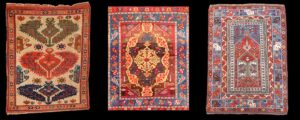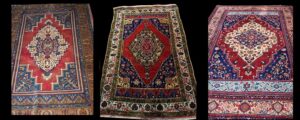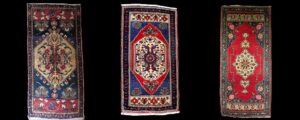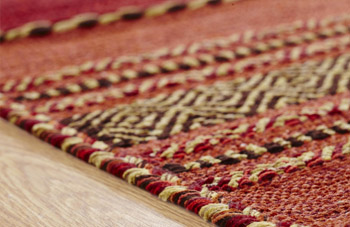Hilmi Demirci is the owner of Himi’s Rug Store and washing facility (name) in Ankara. Being the third generation in a family of carpet merchants from Nigde, well-known carpet weaving region, he has been working in a field of hand woven carpets and textiles for more than 30 years. He says that he was born next to a carpet loom. After elementary school he started learning carpet business from his father in Ulus – Opera square, Ankara, where textiles and rugs from all other towns of Anatolia were on sale. He opened his own repair shop in Ankara in 1987. When the rug store was opened in Ulus? and moved it to Balgat in 2001. A washing and cleaning facilitiy was established in 2004. Among all hand woven textiles Sumak are his favorite, because they are made very strongly with traditional motifs and with long lasting life. His greatest interest is in nomadic gran bags, yastiks and ethnic personal weavings. In his words, among his clients are carpet collectors who, for example, bought over 300 pieces in 3 years. Many other rug and textile lovers decorate their homes with his rugs and textiles. Contact: hilmi@hilmisrugstore.com
TASHPINAR VILLAGE RUGS
The earliest bone and ivory needles were found in Central Asia dated back to 40.000 BCE. It indicates that sewing and weaving art must have started in this area. Pazyryk rug from Altai Mountains, south Siberia dated to 400 BCE known as the earliest one. It was woven probably in a village tradition even if it is very sophisticated with its construction and weaving type.
Turks of Anatolia brought their weaving tradition along with them when they migrated towards west from Central Asia in Middle Ages. Earliest Anatolian carpets were made by Seljuk Turks in 13-14th centuries. They did not change their tradition in 15th -16th centuries when Europe demanded to import large size of carpets for their palaces and homes. They did not use them on the floor but decorated their walls, tables and halls during ceremonies.
Village rugs are still being made in major areas where the tradition still survives. As usual, village rug weavers are past nomads. Even if they settled in villages to end their pastoral live, they keep their weaving traditions. They produce main rugs, prayer rugs, bedding pile covers, vanity bags, saddlebags, pillow covers (yastiks) and various sizes of flat weavings. Village rugs were made for personal use as well as for sale in nearby bazaars and markets. Until 1980s many village markets still existed in various places of Turkey. Weaving of rugs is one of the textile arts of women to impress their husbands. Usually, they are the masters of their homes. Most men know that their wives are the masters in the house and they act accordingly with respect towards them. In older days, almost all young girls wove rugs and textiles for their own dowry as preparation for wedding ceremony. It was important to display the dowry before the wedding for people to see how talented she was.

Anatolian village rugs
Village rugs are made by women with tradition, care and love. The motifs express their wishes and desires, sorrow and happiness, the need of protection from harm and other bad life experiences. Special rugs had been woven to protect babies from harmful bugs and insects. For example, Balikesir Yuncu long pile knotted and flat woven rugs, Konya “Filikli” tulu rugs had been used for this purpose.
To make a rug the weavers first of all prepare certain amount of wool, depending what they will weave, a main rug, a yastik, a saddlebag or something else, by washing, carding and spinning the wool. They choose designs passed over from their grandparents. Medallions or overall designs are common as well as some religious patterns with village scenes in borders. Yastiks are made like small rugs with medallions, borders and other details. They have been used to cover flat couches and on the floor for leaning and resting. Personal prayer rugs were always put away after praying and have kept with care and respect.
Villagers have used best available natural dyes from countryside. They knew every local wild plant around. It is an art and challenge to make a great naturally dyed rug. There were traveling wool dyers who used to come in spring and fall to dye wool yarns for weavers in villages and weaving centers. Village rugs have been made in different sizes for their own homes and living areas. Long and wide runners like main rugs, in size of 160-175 cm by 275 – 350 cm, small area rugs, in size of 130-150 cm by 200-230 cm and prayer rugs in size of 90 cm by 125cm, which have been used during prayers and for wall hanging as decorations since Islam prohibits paintings. In older days, one could see Muslim men taking their personal prayer rugs when they were going to Friday prayers.

Tashpinar village rugs
After 1980s Turkey went under a great change in the village and workshop textile arts. Country was opened to Western world with Mediterranean Sea coasts. Many European tourists began to visit Turkey. It forced rug merchants to push village rug industry to produce rugs faster in order to supply the demand on tourism market. They established cooperatives and associations to control the production. Also, they started to supply the weavers with looms and hand or machine spun dyed wool in various qualities.
The traditional rug weaving in villages was changing slowly but surely. Designs and sizes have been changed by standards and demands of Europe. Very often rugs were washed with chemicals to give them more subdued attractive colors. Many other new methods had applied, such as clipping down brown-black color pile yarns for aged look, lowering piles and rolling in dust-tumblers for soft handle?. Gradually traditional village rug making had lost its unique specifications. Also, a rapid development of machine-made rugs had created a dilemma for village rugs. Machine-made rugs have quickly replaced handmade rugs because of their low cost and easy washing and cleaning process. Nevertheless, some weaving areas still keep the traditional weaving for their own use. Tashpinar is one of them. In this area Tashpinar rugs are still woven in small scales. A group of women had started a cooperative movement of revival village Tashpinar rugs in some nearby villages and Tashpinar village.

Tashpinar Yastik rugs
Also, in western Anatolia, DOBAG village rugs project started under the name “Return to Tradition” with natural dyes in Bergama – Yuntdag area. Dr. Harald Bohmer and Marmara University team established it in 1981 and it is still going on today. They make some of the great natural dye handmade rugs. Konya and a few other Central Anatolian towns, such as Gordes at Manisa Province, Karaman and Karapinar at Konya, Sultanhani, Aksaray and Doshemealti at Antalya have also natural dye village rug and kilim making projects under private sector companies. I think that traditional rug making will survive in Anatolia and around for some more years. Textile modern technologies will take over at the long run. However, Anatolia will be one of the last places to lose its hand weaving art and traditions. On my opinion, Universities must open faculties with classes of weaving and traditional textile arts. Turkish Ministry of Culture must support new carpet making and textile weaving projects. It is happening in some scale in these days by private sector. Latest one is called patchwork rugs and floor spreads, which are kind of fashion in western world in these days.
Hilmi Demirci.

